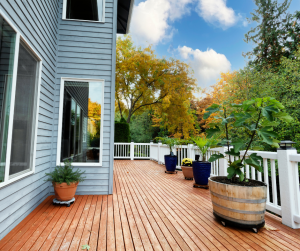
Wood: An Ideal Material For Landscaping in 2022
Wood has been a mainstay in landscaped gardens for centuries. Often used to outline borders and create raised beds, wood provides structure in the garden and a framework for flowers and other plants to shine. Unlike other materials like metal or plastic, wood has a natural appearance that adds to the beauty of your garden.
Both treated and untreated forms of wood can be used in landscaping, but it’s important to know which type and species of wood is best for each particular part of your garden. Treated wood has the added benefit of resisting rot, decay and insects, meaning that treated wood can keep its appearance and strength for years in your garden. With these qualities, treated wood makes for a great material in building trellises, sheds and raised flower beds. However, it is recommended that you do not use treated wood where you will be growing plants that you intend to eat. This is because the chemicals used in treated wood can leach into the soil, making nearby plants unsafe for consumption.
Although untreated wood does not have quite the same level of protection against pests, decay and rot, it is readily available and a safer alternative for usage around plants that are likely to be consumed, like fruits and vegetables. Both forms of wood will eventually decay over the years, especially is exposed to excessive sunlight and/or moisture. However, many gardeners and landscapers appreciate older, weathered wood as it provides an appealing aesthetic and gives the appearance of age to the garden.

Many gardeners know the importance of height in a garden, and using wood is a great way to implement it. Wooden structures like trellises, gazebos, terraces and pergolas can be a beautiful addition to your garden, and provide climbing plants like grapes and runner beans with the ideal growing platform. Once established these plants provide attractive colours and valuable shade to your garden, enabling you to rest underneath on hot, sunny days in cool comfort.
The forests of Vancouver Island provide some of the highest-grade softwood timber in the world. Although we specialize in Western Red Cedar, at Longhouse we also work with interior and coastal softwoods, such as yellow cypress (cedar), Douglas-fir, Pacific Coast hemlock, and spruce pine fir. Specialty products manufactured by our team include custom cut yellow cedar decking, solid wood flooring, cedar fascia and soffits, different varieties of FSC (Forest Stewardship Council)® certified cedar siding—both sourced from Vancouver Island’s coastal rainforests, Japanese grade spruce siding, white oak flooring, and Douglas Fir products (flooring, timbers, and beams).
Longhouse Forest Products offers a wide selection of wood materials that are sustainably sourced from right here on Vancouver Island. As a demonstration of our commitment to sustainability, Longhouse is a member of the Canadian Green Building Council. The mission of this council is to transform building in Canada by promoting practices that further sustainability across the country. As a reflection of our devotion to practicing sustainable practices and providing high-quality products, Longhouse is the two-time Manufacturer/Supplier of the Year by the Vancouver Island Construction Association (VICA) for both 2019 and 2020.
With our decades of experience in the forestry product industry and numerous accolades, Longhouse can provide the products and the know-how to turn your dream project into a reality. Call us toll-free at 1-800-811-2010 or email us at info@longhousecedar.com to find out more about the products and services we can provide for you.
